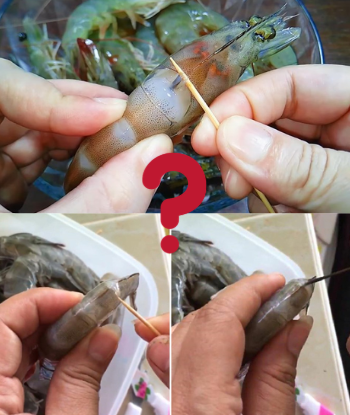
When it comes to family dinners, food choices can quickly become personal. What one person considers “perfectly fine” can be a dealbreaker for another. Recently, a simple shrimp dish sparked a bigger question: is deveining shrimp a must, or is it just a matter of preference? While shrimp are loved around the world for their versatility and sweet flavor, their preparation varies greatly across cultures and kitchens. Let’s dive into what deveining really means, why it matters, and how to approach this often-debated seafood step.
Understanding Shrimp Preparation
Shrimp can be cooked with or without their shells, grilled, sautéed, steamed, or fried — the options are endless. But the debate over deveining comes down to one thing: the dark line running along the shrimp’s back. That “vein” is actually the digestive tract. Removing it is purely optional, but many home cooks and chefs believe it makes for a cleaner, more appealing dish.
What Exactly Is Deveining?
Deveining involves making a shallow cut along the back of the shrimp and pulling out the digestive tract. While it’s not harmful to eat, it can sometimes contain sand, grit, or partially digested food. For some, that’s more about aesthetics than health. A perfectly deveined shrimp looks cleaner, feels smoother in the mouth, and avoids any unpleasant grit.
Health Implications of Eating Undeveined Shrimp
From a food safety standpoint, undeveined shrimp is generally fine to eat if cooked thoroughly. The vein won’t make you sick, but it can affect taste and texture. If the shrimp has been harvested from clean waters, the digestive tract will likely be barely noticeable. However, those sensitive to texture or appearance may find undeveined shrimp less appetizing.
Video : How to remove shrimp strings quickly with just 1 straw!
Cultural Perspectives on Deveining
In many Asian, Mediterranean, and Caribbean cuisines, shrimp are cooked and served whole — shells, heads, and veins intact. This is not laziness; it’s flavor preservation. The shells hold in moisture and add depth to soups, curries, and stir-fries. In Western cooking, especially fine dining, deveining is more common to achieve a pristine, elegant presentation. Neither approach is “right” or “wrong” — it’s simply tradition and preference.
Personal Preferences and Presentation
For some diners, food presentation is as important as flavor. A visible vein can be off-putting, even if it poses no health risk. Parents often choose deveined shrimp for children to avoid any texture surprises. On the other hand, seasoned seafood lovers may not mind — especially if they know the shrimp is fresh and well-cooked.
How to Devein Shrimp Like a Pro
If you prefer your shrimp deveined, the process is simple:
- Rinse the shrimp under cold water to remove any surface debris.
- Peel the shell if desired, leaving the tail intact for presentation.
- Use a small paring knife or deveining tool to make a shallow cut along the back.
- Lift out the vein with the tip of the knife and discard it.
- Rinse again to ensure no grit remains.
This extra step adds just a few minutes to prep time but can make a noticeable difference in the final dish.
Navigating Food Preferences in a Family Setting
Discussing food preferences with family can be tricky — especially if it involves questioning someone’s cooking method. The key is respect. Acknowledge the effort that went into preparing the meal before sharing your preference. Suggesting a middle ground, like deveining half the shrimp, can keep everyone happy. Good communication ensures that tradition and personal comfort can coexist at the dinner table.
Video : How to PEEL, CLEAN & DEVEIN PRAWNS and Shrimp | Bart van Olphen
Conclusion: A Matter of Taste and Tradition
Deveining shrimp is not a strict culinary requirement. It’s a choice shaped by culture, texture preferences, and presentation goals. While it doesn’t drastically impact health, many prefer the cleaner look and taste of deveined shrimp. The best approach is to balance tradition with personal comfort — especially when sharing meals with loved ones. After all, the real goal of any dish is to bring people together, whether the shrimp is deveined or not.


